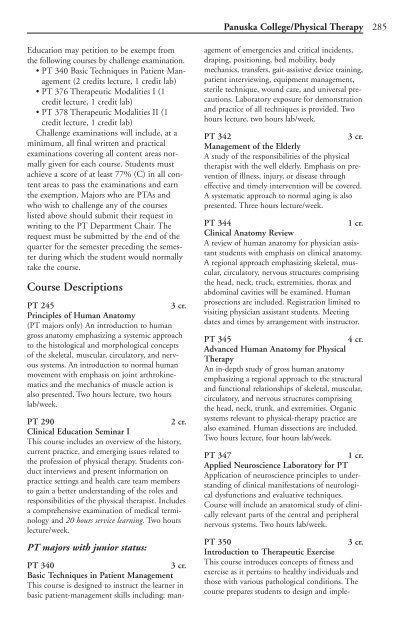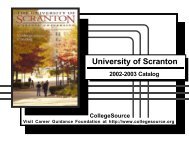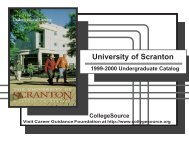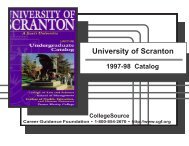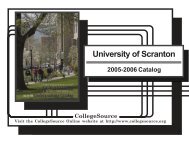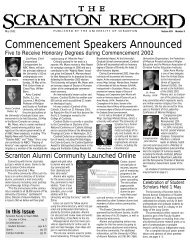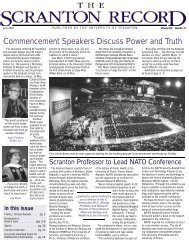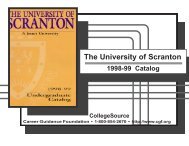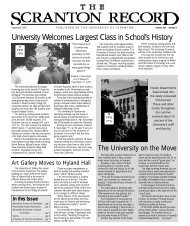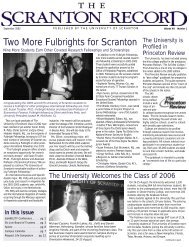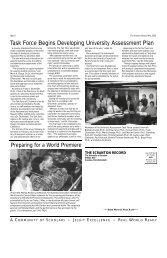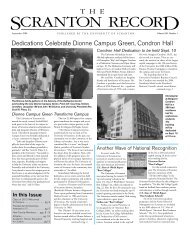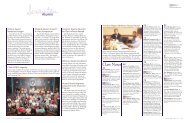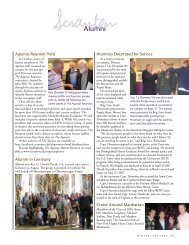2003-2004 - The University of Scranton
2003-2004 - The University of Scranton
2003-2004 - The University of Scranton
You also want an ePaper? Increase the reach of your titles
YUMPU automatically turns print PDFs into web optimized ePapers that Google loves.
Education may petition to be exempt from<br />
the following courses by challenge examination.<br />
• PT 340 Basic Techniques in Patient Management<br />
(2 credits lecture, 1 credit lab)<br />
• PT 376 <strong>The</strong>rapeutic Modalities I (1<br />
credit lecture, 1 credit lab)<br />
• PT 378 <strong>The</strong>rapeutic Modalities II (1<br />
credit lecture, 1 credit lab)<br />
Challenge examinations will include, at a<br />
minimum, all final written and practical<br />
examinations covering all content areas normally<br />
given for each course. Students must<br />
achieve a score <strong>of</strong> at least 77% (C) in all content<br />
areas to pass the examinations and earn<br />
the exemption. Majors who are PTAs and<br />
who wish to challenge any <strong>of</strong> the courses<br />
listed above should submit their request in<br />
writing to the PT Department Chair. <strong>The</strong><br />
request must be submitted by the end <strong>of</strong> the<br />
quarter for the semester preceding the semester<br />
during which the student would normally<br />
take the course.<br />
Course Descriptions<br />
PT 245 3 cr.<br />
Principles <strong>of</strong> Human Anatomy<br />
(PT majors only) An introduction to human<br />
gross anatomy emphasizing a systemic approach<br />
to the histological and morphological concepts<br />
<strong>of</strong> the skeletal, muscular, circulatory, and nervous<br />
systems. An introduction to normal human<br />
movement with emphasis on joint arthrokinematics<br />
and the mechanics <strong>of</strong> muscle action is<br />
also presented. Two hours lecture, two hours<br />
lab/week.<br />
PT 290 2 cr.<br />
Clinical Education Seminar I<br />
This course includes an overview <strong>of</strong> the history,<br />
current practice, and emerging issues related to<br />
the pr<strong>of</strong>ession <strong>of</strong> physical therapy. Students conduct<br />
interviews and present information on<br />
practice settings and health care team members<br />
to gain a better understanding <strong>of</strong> the roles and<br />
responsibilities <strong>of</strong> the physical therapist. Includes<br />
a comprehensive examination <strong>of</strong> medical terminology<br />
and 20 hours service learning. Two hours<br />
lecture/week.<br />
PT majors with junior status:<br />
PT 340 3 cr.<br />
Basic Techniques in Patient Management<br />
This course is designed to instruct the learner in<br />
basic patient-management skills including: man-<br />
Panuska College/Physical <strong>The</strong>rapy 285<br />
agement <strong>of</strong> emergencies and critical incidents,<br />
draping, positioning, bed mobility, body<br />
mechanics, transfers, gait-assistive device training,<br />
patient interviewing, equipment management,<br />
sterile technique, wound care, and universal precautions.<br />
Laboratory exposure for demonstration<br />
and practice <strong>of</strong> all techniques is provided. Two<br />
hours lecture, two hours lab/week.<br />
PT 342 3 cr.<br />
Management <strong>of</strong> the Elderly<br />
A study <strong>of</strong> the responsibilities <strong>of</strong> the physical<br />
therapist with the well elderly. Emphasis on prevention<br />
<strong>of</strong> illness, injury, or disease through<br />
effective and timely intervention will be covered.<br />
A systematic approach to normal aging is also<br />
presented. Three hours lecture/week.<br />
PT 344 1 cr.<br />
Clinical Anatomy Review<br />
A review <strong>of</strong> human anatomy for physician assistant<br />
students with emphasis on clinical anatomy.<br />
A regional approach emphasizing skeletal, muscular,<br />
circulatory, nervous structures comprising<br />
the head, neck, truck, extremities, thorax and<br />
abdominal cavities will be examined. Human<br />
prosections are included. Registration limited to<br />
visiting physician assistant students. Meeting<br />
dates and times by arrangement with instructor.<br />
PT 345 4 cr.<br />
Advanced Human Anatomy for Physical<br />
<strong>The</strong>rapy<br />
An in-depth study <strong>of</strong> gross human anatomy<br />
emphasizing a regional approach to the structural<br />
and functional relationships <strong>of</strong> skeletal, muscular,<br />
circulatory, and nervous structures comprising<br />
the head, neck, trunk, and extremities. Organic<br />
systems relevant to physical-therapy practice are<br />
also examined. Human dissections are included.<br />
Two hours lecture, four hours lab/week.<br />
PT 347 1 cr.<br />
Applied Neuroscience Laboratory for PT<br />
Application <strong>of</strong> neuroscience principles to understanding<br />
<strong>of</strong> clinical manifestations <strong>of</strong> neurological<br />
dysfunctions and evaluative techniques.<br />
Course will include an anatomical study <strong>of</strong> clinically<br />
relevant parts <strong>of</strong> the central and peripheral<br />
nervous systems. Two hours lab/week.<br />
PT 350 3 cr.<br />
Introduction to <strong>The</strong>rapeutic Exercise<br />
This course introduces concepts <strong>of</strong> fitness and<br />
exercise as it pertains to healthy individuals and<br />
those with various pathological conditions. <strong>The</strong><br />
course prepares students to design and imple-


